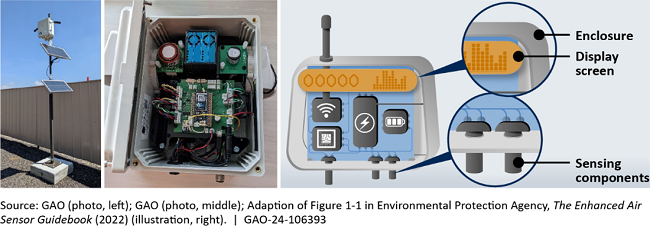Air Quality Sensors: Policy Options to Help Address Implementation Challenges
Fast Facts
Portable, low-cost air quality sensors could identify pollution hot spots, improve wildfire smoke warnings, and provide air quality information in rural areas.
Current sensors are accurate enough to accomplish these tasks for some pollutants, but more capabilities are still in development. Also, there are challenges to using these sensors. For example, users may not have access to the expertise and information they need to deploy the sensors appropriately and interpret their data.
We assessed sensor technology and identified 7 policy options to address the challenges.
Smoke from the Marshall Fire in Boulder County, CO, on December 30, 2021

Highlights
What GAO Found
Lower-cost air quality sensors (sensors) are portable devices that can measure local air quality in real time. Although these sensors are generally less accurate than more expensive instruments, they can be deployed in large number to supplement information provided by the national air quality monitoring system. Among their many uses are identifying pollution hot spots, monitoring industrial sites and nearby neighborhoods, and conducting scientific research. Sensors can be more accurate for some pollutants, such as fine particulate matter, than others. They are as of yet unavailable for certain air toxics such as benzene and metals.
Air Quality Sensors

GAO identified several challenges users face in implementing sensor technologies. For example, some users have struggled to:
Access expertise and resources. Some users may lack the knowledge or funding to select the right sensors or deploy them in a way that best fits their goals. Potential sources of expertise—such as universities or state and local agencies responsible for air quality management—may lack incentives or resources to partner with those users.
Understand sensor capabilities. Some vendors are not transparent about sensor performance. For example, some stakeholders told GAO that some vendors claim capabilities that are questionable. In the absence of reliable information on performance, users may struggle to choose appropriate sensors.
Compile and compare sensor data. Sensors produce data in many formats, and there are currently no widely accepted standards for reporting data from these different formats. In addition, some users do not report metadata that describe information such as environmental conditions or correction factors. Both issues can make it difficult for users to compile or compare data.
Spur action. Some users collect sensor data to spur action. But users and decision-makers may have different expectations about the level of quality assurance required. For example, some users seek evidence of pollutants that could trigger regulators to investigate a pollution source. However, these users may not realize that their data are not of sufficient quality for that purpose due to unclear guidance on the level of quality assurance needed.
GAO identified seven policy options that could help address challenges to developing and using air sensors. The options identify possible actions by policymakers, including legislative bodies, government entities, academia, industry, and other groups. See tables 5–11 in the report for a full list of the policy options, potential implementation approaches, and opportunities and considerations.
Policy Options to Address Challenges to Developing and Using Air Sensors
| Policy Option | Opportunities | Considerations |
|---|---|---|
| Maintain status quo (report p. 31) |
|
|
| Enhance sensor performance transparency (report p. 32) For example, government entities or standards-setting organizations could establish additional standardized performance testing protocols and targets. |
|
|
| Support innovation in sensor technologies (report p. 33) For example, the sensor industry could choose to invest in additional research and development to improve existing sensors or develop new sensor technologies. |
|
|
| Facilitate access to expertise (report p. 34) For example, universities could collaborate with others to establish technical assistance mechanisms that connect users with experts. |
|
|
| Improve access to guidance (report p. 35) For example, nonprofit organizations and other policymakers could collaborate with others to maintain a website with links to or copies of existing guidance. |
|
|
| Improve data management and sharing (report p. 36) For example, standards-setting organizations could collaborate with others to develop data and metadata standards. |
|
|
| Clarify level of quality assurance needed to spur action (report p.37) For example, government entities could collaborate with others to develop guidance on the level of quality assurance required for various applications. |
|
|
Source: GAO. | GAO-24-106393
Why GAO Did This Study
U.S. ambient air quality is monitored by federal, state, and local agencies through the national ambient air quality monitoring system. However, that system is unable to provide some of the information that users may need to better manage health risks from air pollution. Lower-cost air quality sensors have the potential to help meet some of the monitoring information needs that require pollution measurements in additional locations or more real-time data.
This report describes (1) sensor technologies for monitoring air quality, (2) their benefits and uses, (3) how well they perform and factors that affect their performance, (4) challenges to their use, and (5) options policymakers could consider to help address these challenges.
GAO reviewed key reports and scientific literature; interviewed federal and state agency officials and other stakeholders from academia, industry, and nongovernmental organizations; attended a workshop on issues related to lower-cost air quality sensors; and convened a 2-day meeting of 12 experts. These experts included those who conduct research on sensor technologies and their uses, develop or manufacture sensor technologies, or use or consider using sensor technologies and data. GAO is identifying policy options in this report.
For more information, contact Karen L. Howard at (202) 512-6888 or howardk@gao.gov or J. Alfredo Gómez at (202) 512-3841, GomezJ@gao.gov.
